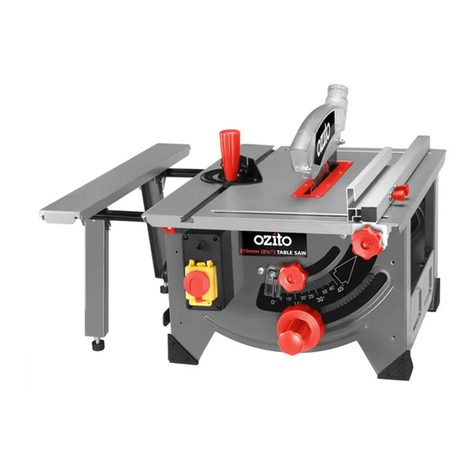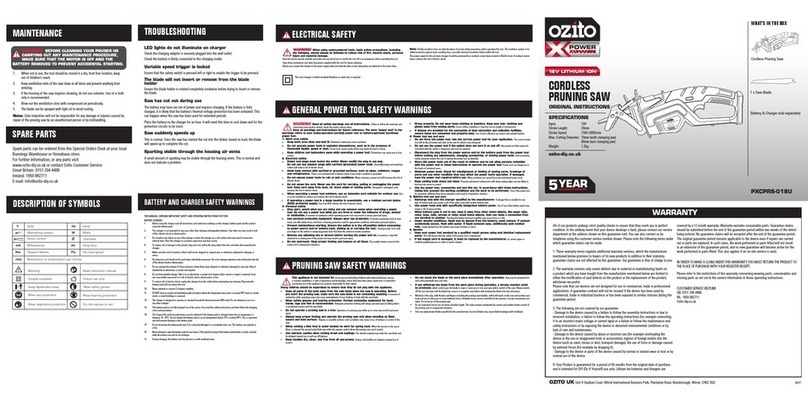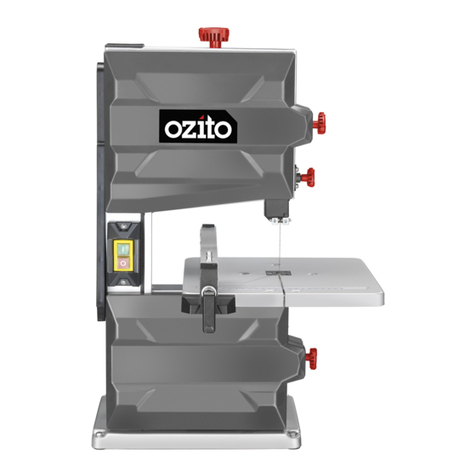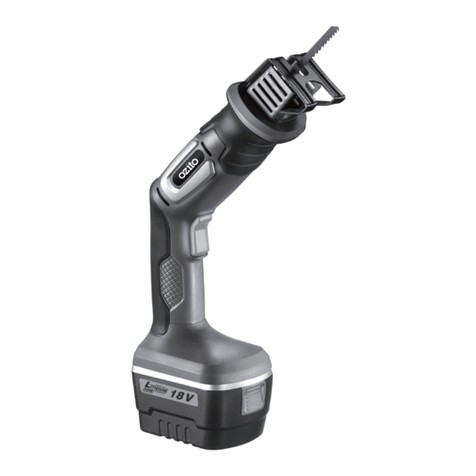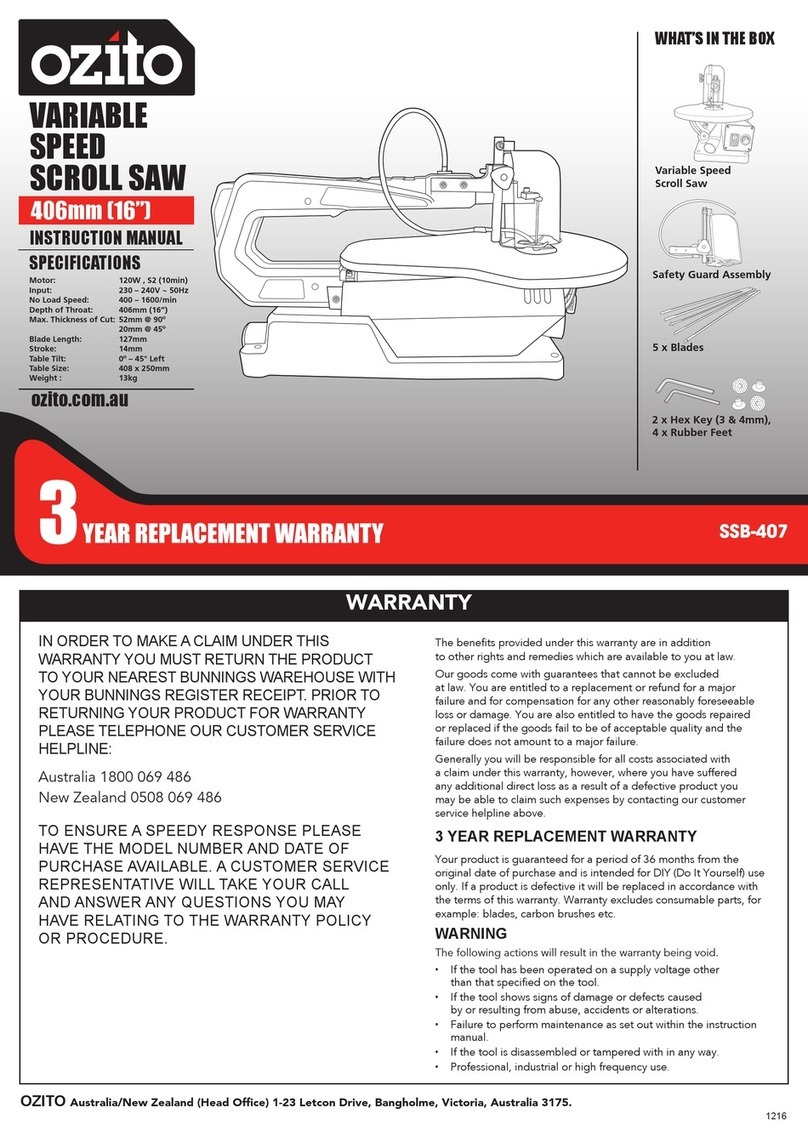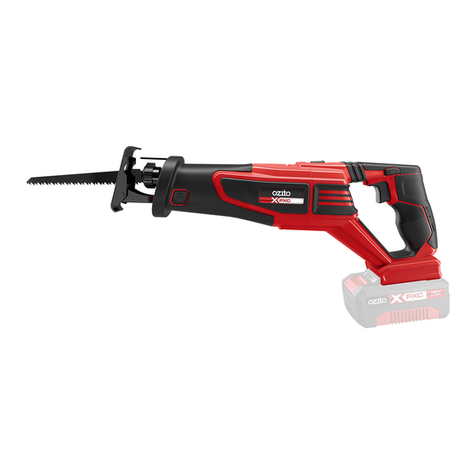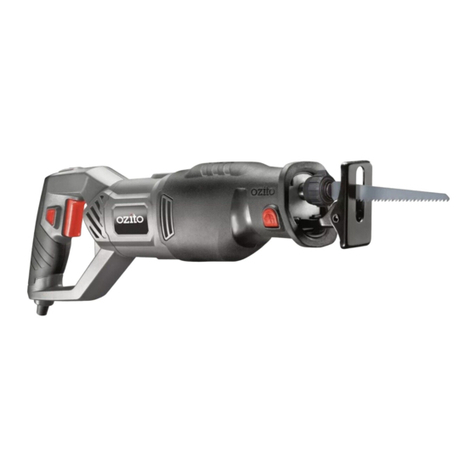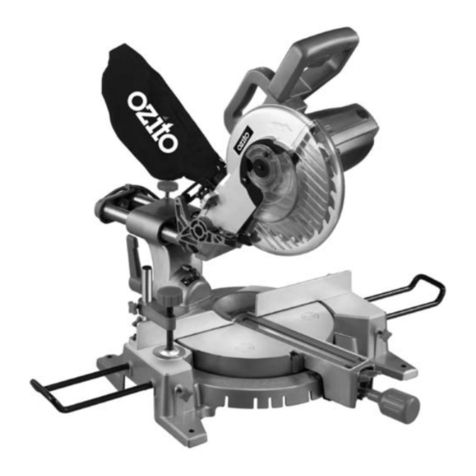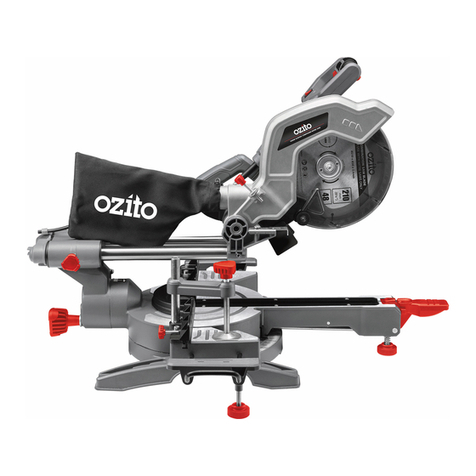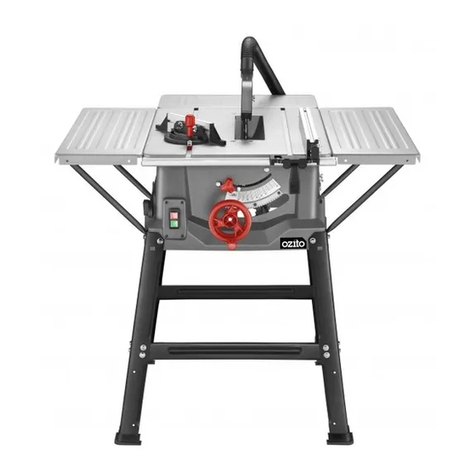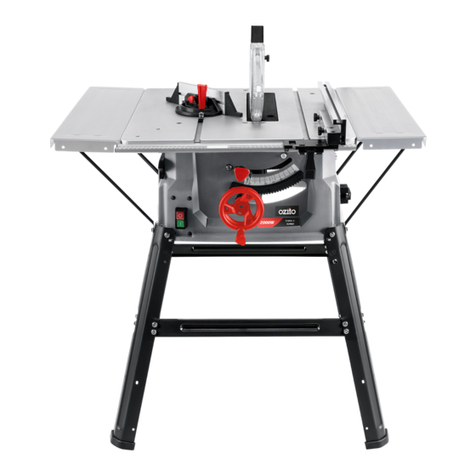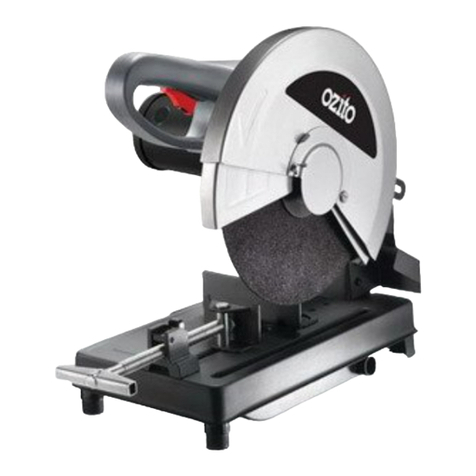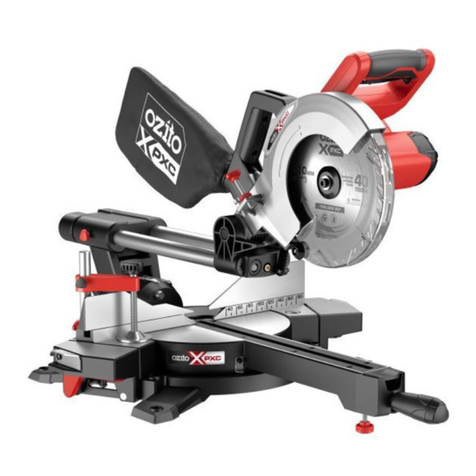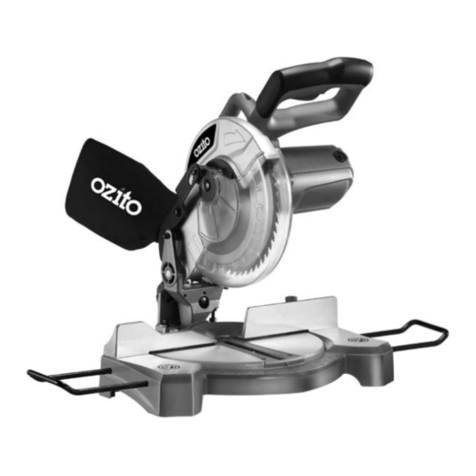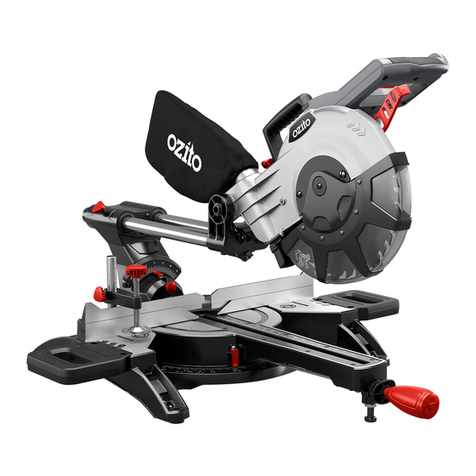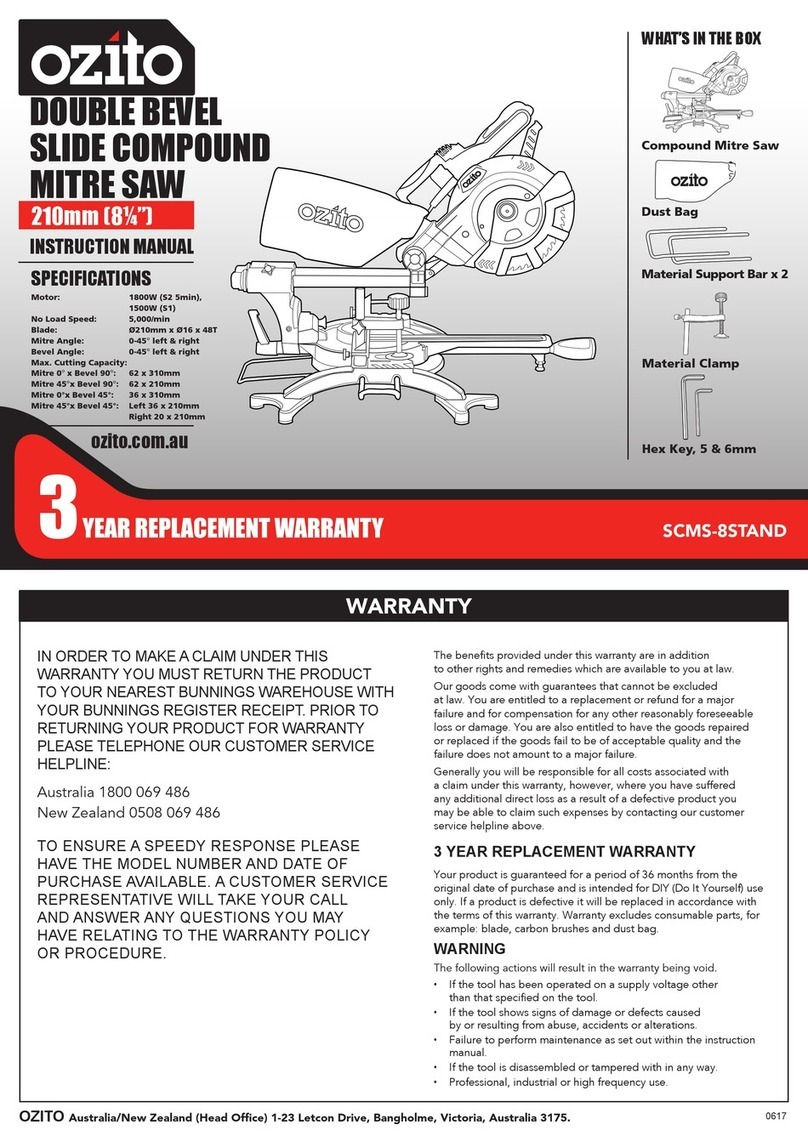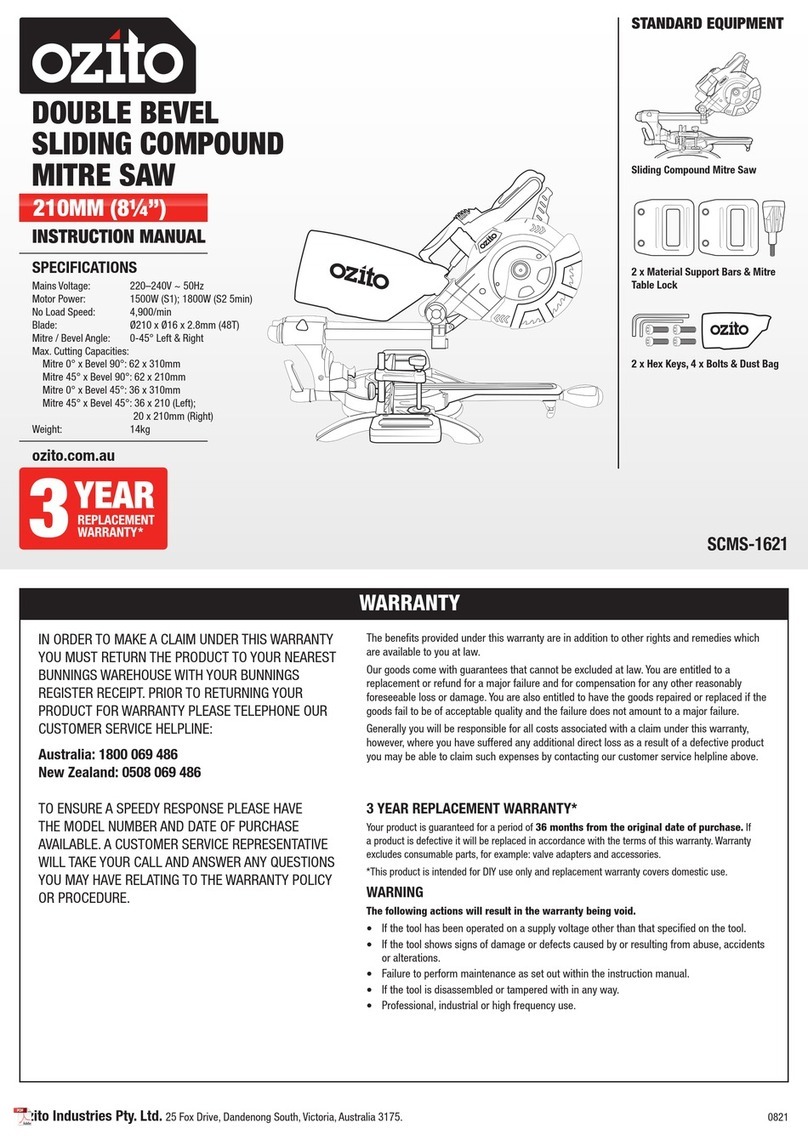This appliance is not intended for use by young or inrm persons unless supervised by a
responsible person to ensure that they can use the appliance safely.
Young children should be supervised to ensure that they do not play with the appliance.
WARNING!
Keep hands away from the cutting area and cutting disc. NEVER place
your hand behind the cutting disc. Do not attempt to remove cut material when cutting
disc is moving. Contact with the cutting disc may cause serious personal injury.
• Keep the lower guard attached and working properly. Ensure the guard is in the
maximum cutting disc covering position over the workpiece. Do not use the cutting off
grinders without guards in position.
• Keep your body positioned to either side of the cutting disc, but not in line with the
cutting disc. It is important to position your body and the guard to minimize body exposure
from the possible fragments of a disintegrating cutting disc.
• Abrasive cutting discs must have a maximum safe operating speed greater than the
“no load RPM” marked on the rating label. Cutting discs running over the rated speed
can disintegrate and cause injury.
• Use proper apparel while using an abrasive cut-off machine. This includes face shield,
safety goggles, dust mask and gloves.
• Before each use, inspect the cutting disc for chips and cracks. Do not use a cutting
disc that may be damaged. Fragments from a cutting disc that disintegrates during
operation can cause serious injury or property damage.
• Always use the vice to clamp the work and properly support the over-hanging portion
of the workpiece level with the table of the machine. Proper support of the workpiece is
important to keep the cut-off and over-hanging metal from falling and striking the operator.
• Do not force the abrasive cutting disc into the work or apply excessive pressure
while using the machine. Avoid bouncing the cutting disc or giving it rough treatment. If
the cutting disc is damaged due to misuse, it may develop cracks and disintegrate without
warning.
• Use only cutting discs recommended by the manufacturer. The cutting disc should have
marked speed equal to or greater than that marked on the machine. Read the operating
instructions supplied by the cutting disc manufacturer.
• Do not use a metal circular saw blade or toothed blades. These blades are not intended
for this machine and could create loss of control during use or cause injury to persons and
damage to property.
• Do not attempt to cut wood or plastic with this tool. Cutting wood and plastic could
cause them to burn due to friction heating.
• Do not attempt to cut masonry. Dust generated by cutting masonry will clog the motor
causing premature failure and thereby voiding the warranty.
• Do not operate this tool near ammable liquids, gasses or dust. Sparks from the motor
or cutting may ignite dust and fumes.
• Never cut magnesium with this tool. The dust generated when cutting magnesium is
highly ammable and may be explosive under certain conditions.
Regularly clean the tool’s air vents with compressed air. Excessive accumulation of
powered metal inside the motor housing may cause electrical failures.
Cutting capacity
The wide vice opening and high pivot point provide cutting capacity for many large pieces. Use
the cutting capacity chart below to determine the maximum size of cuts that can be made with
a new wheel.
CAUTION:
Certain large, circular or irregularly shaped objects may require additional
holding means if they cannot be held securely in the vice.
CAUTION:
Do not cut magnesium with this tool.
Note:
Capacity shown on the chart assumes no cutting disc wear and optimum fence position.
CUT-OFF SAW SAFETY WARNINGS
WARNING! When using mains-powered tools, basic safety precautions, including
the following, should always be followed to reduce risk of re, electric shock,
personal injury and material damage.
Read the whole manual carefully and make sure you know how to switch the tool off in an
emergency, before operating the tool.
Save these instructions and other documents supplied with this tool for future reference.
The electric motor has been designed for 230V and 240V only. Always check that the power supply
corresponds to the voltage on the rating plate.
Note: The supply of 230V and 240V on Ozito tools are interchangeable for Australia and
New Zealand.
This tool is double insulated therefore no earth wire is required.
Using an Extension Lead
Always use an approved extension lead suitable for the power input of this tool. Before use, inspect
the extension lead for signs of damage, wear and ageing. Replace the extension lead if damaged
or defective.
When using an extension lead on a reel, always unwind the lead completely. Use of an extension
lead not suitable for the power input of the tool or which is damaged or defective may result in a risk
of re and electric shock.
WARNING! Read all safety warnings and all instructions. Failure to follow the
warnings and instructions may result in electric shock, re and/or serious injury.
Save all warnings and instructions for future reference. The term “power tool” in the
warnings refers to your mains-operated (corded) power tool or battery-operated (cordless)
power tool.
1. Work area safety
a. Keep work area clean and well lit. Cluttered or dark areas invite accidents.
b.
Do not operate power tools in explosive atmospheres, such as in the presence of ammable
liquids, gases or dust. Power tools create sparks which may ignite the dust or fumes.
c. Keep children and bystanders away while operating a power tool. Distractions can cause
you to lose control.
2. Electrical safety
a. Power tool plugs must match the outlet. Never modify the plug in any way.
Do not use any adapter plugs with earthed (grounded) power tools. Unmodied plugs and
matching outlets will reduce risk of electric shock.
b. Avoid body contact with earthed or grounded surfaces, such as pipes, radiators, ranges
and refrigerators. There is an increased risk of electric shock if your body is earthed or
grounded.
c. Do not expose power tools to rain or wet conditions. Water entering a power tool will
increase the risk of electric shock.
d. Do not abuse the cord. Never use the cord for carrying, pulling or unplugging the power
tool. Keep cord away from heat, oil, sharp edges or moving parts. Damaged or entangled
cords increase the risk of electric shock.
e. When operating a power tool outdoors, use an extension cord suitable for outdoor use.
Use of a cord suitable for outdoor use reduces the risk of electric shock.
f. If operating a power tool in a damp location is unavoidable, use a residual current device
(RCD) protected supply. Use of an RCD reduces the risk of electric shock.
3. Personal safety
a. Stay alert, watch what you are doing and use common sense when operating a power
tool. Do not use a power tool while you are tired or under the inuence of drugs, alcohol
or medication.
A moment of inattention while operating power tools may result in serious personal injury.
b. Use personal protective equipment. Always wear eye protection. Protective equipment
such as dust mask, non-skid safety shoes, hard hat, or hearing protection used for appropriate
conditions will reduce personal injuries.
c. Prevent unintentional starting. Ensure the switch is in the off-position before connecting
to power source and/or battery pack, picking up or carrying the tool. Carrying power
tools with your nger on the switch or energising power tools that have the switch on invites
accidents.
d. Remove any adjusting key or wrench before turning the power tool on.
A wrench or a key left attached to a rotating part of the power tool may result in personal injury.
e. Do not overreach. Keep proper footing and balance at all times. This enables better control
of the power tool in unexpected situations.
f. Dress properly. Do not wear loose clothing or jewellery. Keep your hair, clothing and gloves
away from moving parts. Loose clothes, jewellery or long hair can be caught in moving parts.
g. If devices are provided for the connection of dust extraction and collection facilities,
ensure these are connected and properly used. Use of dust collection can reduce dust-
related hazards.
4. Power tool use and care
a. Do not force the power tool. Use the correct power tool for your application. The correct
power tool will do the job better and safer at the rate for which it was designed.
b. Do not use the power tool if the switch does not turn it on and off. Any power tool that
cannot be controlled with the switch is dangerous and must be repaired.
c. Disconnect the plug from the power source and/or the battery pack from the power tool
before making any adjustments, changing accessories, or storing power tools. Such
preventive safety measures reduce the risk of starting the power tool accidentally.
d. Store idle power tools out of the reach of children and do not allow persons unfamiliar
with the power tool or these instructions to operate the power tool. Power tools are
dangerous in the hands of untrained users.
e. Maintain power tools. Check for misalignment or binding of moving parts, breakage of
parts and any other condition that may affect the power tool’s operation. If damaged,
have the power tool repaired before use. Many accidents are caused by poorly maintained
power tools.
f. Keep cutting tools sharp and clean. Properly maintained cutting tools with sharp cutting
edges are less likely to bind and are easier to control.
g. Use the power tool, accessories and tool bits etc. in accordance with these instructions,
taking into account the working conditions and the work to be performed. Use of the
power tool for operations different from those intended could result in a hazardous situation.
5. Service
a. Have your power tool serviced by a qualied repair person using only identical
replacement parts. This will ensure that the safety of the power tool is maintained.
b. If the supply cord is damaged, it must be replaced by the manufacturer,
its service agent or similarly qualied persons in order to avoid a hazard.
GENERAL POWER TOOL SAFETY WARNINGS
ELECTRICAL SAFETY
Cutting Capacity @ 90º
Round 130mm
Square 120mm
Rectangular 120 x 130mm
Angle iron 140mm
